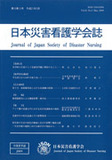Japanese
English
- 有料閲覧
- Abstract 文献概要
- 参考文献 Reference
要約
目的は、震災後に脳卒中を発症した事例から健康に影響を及ぼす震災後の生活の変化を明らかにし、震災後の中・長期に必要な健康支援を検討することである。中越大震災後に脳卒中を発症したA地区住民3名を対象に半構造的面接をし内容分析の結果、149記録単位、71サブカテゴリ、24カテゴリ、4コアカテゴリが抽出された。コアカテゴリの文脈は、発症には【脳卒中につながるといわれる基礎疾患と生活習慣の存在】を背景に、【生活の場のめまぐるしい変化とその影響】のなか、震災前から続く近隣のつながりを維持しようとし、生活のペースを取り戻そうとした結果、【生活の落ち着きを取り戻そうとする努力】、【生活再建のために重ねる無理】が生じたと記述できた。生活の落ち着きが得られない状況下での住民への健康支援として、震災後には関心が薄くなりがちな体調の変化に対する注意喚起、さらに専門職による地域の文化や産業をふまえた基礎疾患や生活状況についての定期的な観察と健康管理行動の支援が重要である。
Abstract
This study aimed to clarify how life changes after an earthquake affect the health status of victims on the basis of the incidence of stroke following the disaster, and identify mid- and long-term health support for them in the post-quake period. A semi-structured interview was held with 3 residents of a district in Niigata Prefecture who had developed stroke after the Great Chuetsu Earthquake, and content analysis of narratives resulted in 149 recorded units, 71 subcategories, 24 categories, and 4 core categories. The context of core categories was described as follows: in the "presence of underlying diseases and lifestyles reportedly leading to stroke," and amid "rapid changes in daily life and their influences," the victims tried to maintain longstanding contact with neighbors and recover previous daily rhythms; consequently, their "efforts to regain daily calm" turned into "accumulating strain during rebuilding their daily life." To provide health support for people in situations where they cannot live comfortably, it is important for health professionals to alert them to changes in their physical condition, often neglected in post-quake confusion, and perform regular monitoring and healthcare activities for underlying illnesses and living conditions in view of the characteristics of local cultures and industries.
Copyright © 2009, Japan Society of Disaster Nursing All rights reserved.


